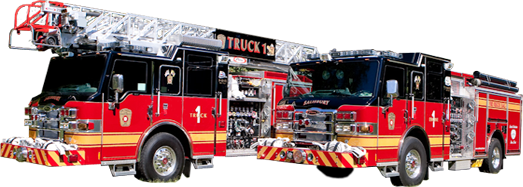Photo Gallery
Some Halloween History and Safety Recommendations
Friday, October 25, 2019
Halloween History
Halloween’s origins date back to the ancient Celtic festival of Samhain (pronounced sow-in). The Celts, who lived 2,000 years ago in the area that is now Ireland, the United Kingdom and northern France, celebrated their new year on November 1. This day marked the end of summer and the harvest and the beginning of the dark, cold winter, a time of year that was often associated with human death. Celts believed that on the night before the new year, the boundary between the worlds of the living and the dead became blurred. On the night of October 31 they celebrated Samhain, when it was believed that the ghosts of the dead returned to earth. In addition to causing trouble and damaging crops, Celts thought that the presence of the otherworldly spirits made it easier for the Druids, or Celtic priests, to make predictions about the future. For a people entirely dependent on the volatile natural world, these prophecies were an important source of comfort and direction during the long, dark winter.
The American Halloween tradition of “trick-or-treating” probably dates back to the early All Souls’ Day parades in England. During the festivities, poor citizens would beg for food and families would give them pastries called “soul cakes” in return for their promise to pray for the family’s dead relatives. The distribution of soul cakes was encouraged by the church as a way to replace the ancient practice of leaving food and wine for roaming spirits. The practice, which was referred to as “going a-souling” was eventually taken up by children who would visit the houses in their neighborhood and be given ale, food, and money.
The tradition of dressing in costume for Halloween has both European and Celtic roots. Hundreds of years ago, winter was an uncertain and frightening time. Food supplies often ran low and, for the many people afraid of the dark, the short days of winter were full of constant worry. On Halloween, when it was believed that ghosts came back to the earthly world, people thought that they would encounter ghosts if they left their homes. To avoid being recognized by these ghosts, people would wear masks when they left their homes after dark so that the ghosts would mistake them for fellow spirits. On Halloween, to keep ghosts away from their houses, people would place bowls of food outside their homes to appease the ghosts and prevent them from attempting to enter.
For lots more info on the history and origin of what we refer to as “Halloween”, visit: http://www.history.com/topics/halloween/history-of-halloween
Halloween Safety Tips
While Halloween may have evolved into a night of fun and games, there are still some factors that should be taken into account in order to ensure everyone involved has as much fun as possible, while maintaining a safe environment for everyone. Here are some Halloween safety tips to take into consideration:
Trick or Treat with an Adult:
Children under the age of 12 should not be alone at night without adult supervision. If kids are mature enough to be out without supervision, they should stick to familiar areas that are well lit and trick-or-treat in groups. Plan your route ahead of time. Let someone know exactly what street(s) you intend to travel and what time to expect you home. Make sure you have a cell phone with you and that each child knows how to utilize/call 9-1-1. However, resist the urge to take tons and tons of pictures while out Trick or Treating. Concentrate on situational awareness.
Walk Safely:
1. Cross the street at corners, using traffic signals and crosswalks.
2. Look left, right and left again when crossing and keep looking as you cross.
3. Put electronic devices down and keep heads up and walk, don’t run, across the street.
4. Teach children to make eye contact with drivers before crossing in front of them.
5. Always walk on sidewalks or paths. Use well-lit streets. If there are no sidewalks, walk facing traffic as far to the left as possible. Children should walk on direct routes with the fewest street crossings.
6. Watch for cars that are turning or backing up. Teach children to never dart out into the street or cross between parked cars.
7. Be cognizant of yard/lawn decorations.
Keep Costumes Both Creative and Safe:
1. Decorate costumes and bags with reflective tape or stickers and, if possible, choose light colors.
2. Choose face paint and makeup whenever possible instead of masks, which can obstruct a child’s vision. Make sure costumes fit well and are the proper length in order to prevent tripping, entanglement, or contact with any flame. Hats should fit properly to prevent any vision obscuring.
3. Have kids carry glow sticks or flashlights to help them see and be seen by drivers.
4. Whether purchasing costumes or making your own, try to utilize fire retardant materials whenever possible.
Drive Extra Safely on Halloween:
1. Slow down and be especially alert in residential neighborhoods. Children are excited on Halloween and may move in unpredictable ways.
2. Take extra time to look for kids at intersections, on medians and on curbs.
3. Enter and exit driveways and alleys slowly and carefully.
4. Eliminate any distractions inside your car so you can concentrate on the road and your surroundings.
5. Drive slowly, anticipate heavy pedestrian traffic and turn your headlights on earlier in the day to spot children from greater distances.
6. Popular trick-or-treating hours are 5:30 p.m. to 9:30 p.m. so be especially alert for kids during those hours.
It’s recommended to wait until you return home to sort and check treats. While tampering is rare, a responsible adult should sort and closely examine all goodies and throw away anything that looks spoiled, is unwrapped, or could be suspicious.
For more information relating to Halloween safety tips, visit: https://www.safekids.org/tip/halloween-safety-tips




